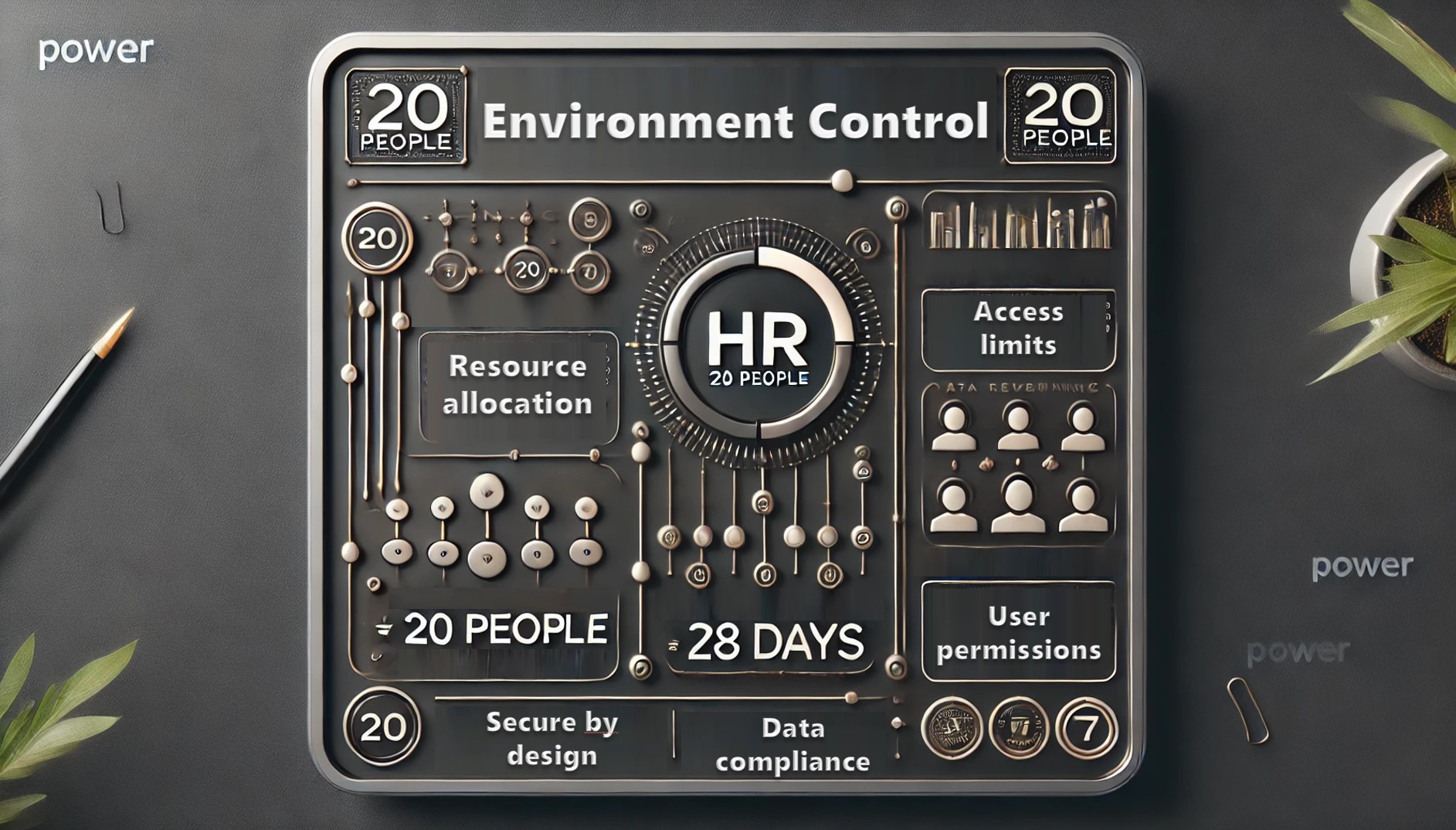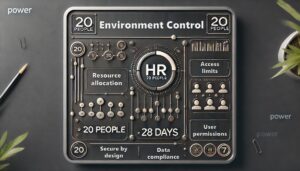35,000 Power Platform environments in a single tenant—sounds overwhelming, right? For most of us, such a tenant would be virtually unmanageable. But at Microsoft, the responsibility of managing it falls to a team of just five people. Known internally as “Tenant 0,” Microsoft has arguably the most complex Power Platform infrastructure in the world—so complex, in fact, that standard tooling simply isn’t capable of scaling to manage it effectively. At this year’s Power Platform Community Conference 2024 (PPCC2024), Microsoft gave us a behind-the-scenes look at how they manage it all.
Sure, most of us will never face the same challenges Microsoft does with Tenant 0, but there’s still a lot we can learn from their governance approach. Just imagine: Microsoft developed an environment management strategy that involves thousands of governance rules and enables them to quickly review and classify risks, all while staying secure and compliant—without slowing down or stifling innovation. The lesson here isn’t about managing thousands of environments; it’s about managing any tenant in a way that’s efficient, safe, and keeps everything running smoothly.
In this blog, we’re going to break down Microsoft’s tenant strategy. We’ll explore how they use environment groups to stay organized, apply governance rules to keep things in check, and handle risk like pros. Whether you’re managing a handful of environments or hundreds, there’s something here for everyone. So, let’s dive into how Microsoft keeps Tenant 0 running like a well-oiled machine—and what you can take away from their approach.
Microsoft’s Challenge
Microsoft had a problem. It had over 100,000 users, 65,000 canvas apps, 12,000 cloud flows, and 5,000 copilots, all being developed in Tenant 0, its largest and most complex Power Platform tenant. Initially, most of these assets were being built in the default environment—an ungoverned space where anyone could create new apps and flows. This led to asset sprawl, an overwhelming situation that made it nearly impossible for the governance team to maintain visibility or control over the platform’s rapidly growing infrastructure.
The default environment—intended as a shared space for experimentation—quickly became a dumping ground for apps, flows, and copilots. With no enforced governance policies, users could freely create and share assets, leaving behind a massive trail of underutilized, orphaned, or overshared resources. This sprawl created significant management challenges:
- Orphaned Assets: A major concern was that many apps and flows were created without clear ownership or purpose. With thousands of users contributing, apps often went unused, unmaintained, or simply abandoned when creators left the organization or changed roles. These orphaned assets not only cluttered the environment but also posed serious business continuity risks—if an important app lacked an owner, who would be responsible for maintaining or troubleshooting it?
- Oversharing: In an open environment with limited governance, users could easily share apps and flows with too many people, both inside and outside of their departments. This created a serious security risk. Sensitive data, embedded in apps and flows, could be unintentionally exposed to unauthorized users, increasing the potential for data breaches or compliance violations.
- Untracked Resources: With no clear mechanism for monitoring the usage of apps and flows, it became difficult to identify which resources were truly critical to the organization and which were clutter. Without insight into how apps were being used—or whether they were being used at all—Microsoft’s governance team had no way to prioritize which apps needed attention and which could be archived or deleted.
The sheer number of apps and users compounded the problem. Managing 100,000 users and tens of thousands of assets in a single tenant, especially without granular governance tools, became a herculean task. Adding to the complexity, tenant-wide visibility was nearly non-existent. Admins lacked the tools to get a clear, unified view of what was happening across Tenant 0. With so many assets and so many makers, it was impossible to get a real-time understanding of how the platform was being used, which assets were critical to business operations, and which were creating unnecessary risk.
In essence, Microsoft found itself drowning in a sea of unmanaged, untracked, and unsecured assets, all being created at a scale that traditional governance tools simply couldn’t handle. The problem wasn’t just that there were too many apps—it was that the system lacked the necessary governance framework to manage the explosion of low-code development happening across the organization. This sprawl posed significant risks, from operational inefficiencies to data security threats, and demanded a new approach to governance in large-scale Power Platform deployments.
Governance Principles in Microsoft's Power Platform Operations
Microsoft’s experience managing a complex Power Platform tenant revealed the necessity of implementing strong governance principles to maintain control over its vast ecosystem of apps, flows, and assets. To meet the challenges posed by asset sprawl on such a massive scale, Microsoft embraced three core governance principles: secure-by-default, manageable, and healthy application lifecycle management (ALM). Each of these principles plays a critical role in ensuring that Microsoft’s internal Power Platform operations remain streamlined and secure.
Secure-by-Default
At the core of Microsoft’s governance strategy is the secure-by-default principle. With over 100,000 users and thousands of apps being developed daily, the potential for accidental data exposure and compliance breaches was significant. To mitigate this, Microsoft adopted an approach that minimizes security risks as assets are created and shared across environments.
The first step in this strategy was establishing a security baseline. Personal development environments were designated as the default for individual makers to experiment and build without putting critical organizational data at risk. These environments are pre-configured with baseline governance policies, including restrictions on access to sensitive connectors and limited sharing capabilities, ensuring that innovation occurs in a safe and controlled environment.
In addition, team productivity environments and enterprise environments were created to accommodate broader collaboration and mission-critical applications. Team environments support departmental or project-based collaboration with built-in governance rules to control data access and prevent oversharing. Meanwhile, enterprise environments are managed with strict access roles and policies to protect the organization’s most sensitive workflows. This structured environment segmentation ensures that apps are developed with the appropriate level of security from the outset.
Manageable
The principle of manageable focuses on providing administrators with the tools to gain full visibility and control over the sprawling Power Platform landscape. Due to the scale of “Tenant 0,” Microsoft needed a way to quickly establish usage profiles of its assets, identify problematic artifacts in its Power Platform environment, and enable administrators to audit the tenant and implement corrective actions at scale.
To help maintain visibility and control over its vast Power Platform ecosystem, Microsoft developed various tools for collecting telemetry data. Detailed information about app usage, flow performance, user activity, and overall resource utilization is integral in identifying failure points, providing insights into performance, capturing usage patterns, and highlighting security or compliance risks. At the time of writing, Microsoft has already beta tested many of these tools and will soon release them, allowing users to capture telemetry data within their own tenants or access AI-powered insights and recommendations based on this data.
Healthy Application Lifecycle (ALM)
The final principle, healthy application lifecycle management (ALM), is critical to ensuring that apps and flows within Tenant 0 are built, deployed, and maintained in a sustainable manner. Without proper ALM practices, apps risk becoming outdated, undermaintained, or unstable—leading to security vulnerabilities and business continuity risks.
For Microsoft, a healthy ALM strategy involves building, deploying, and maintaining apps with rigorous governance, collaboration, and continuous improvement. In the context of Power Platform, this means using several segmented environments during app development. Development typically begins in a sandbox environment, is tested in a quality assurance environment, and finally moves to a production environment.
Microsoft has also implemented pipelines that automatically move apps from development to production based on the principle of Continuous Integration and Continuous Deployment (CI/CD). Additionally, source control is facilitated through tools like Power Platform Build Tools and GitHub Actions, where code repositories such as GitHub or Azure DevOps are used as intermediaries during the deployment process.
Enforcing Governance Principles with Power Platform Managed Environments
To help support these governance principles, Microsoft has created Managed Environments as a key tool for enforcing governance principles across large-scale low-code ecosystems. This feature is designed to streamline the governance of environments by providing a robust framework that integrates security, manageability, and compliance into every stage of app and flow development. Managed Environments helps administrators maintain control over Power Platform assets by automating governance processes, enforcing policies, and offering insights to support decision-making at scale.
Let’s take a detailed look at how these key features support Microsoft’s governance framework:
Limit Sharing
A fundamental element of Microsoft’s secure-by-default governance principle is ensuring that sensitive data and assets are not overly exposed or shared with unauthorized users. In Managed Environments, administrators can set specific sharing restrictions, such as limiting access to only certain individuals or security groups. By restricting unnecessary sharing, Limit Sharing reduces the chances of sensitive business data being circulated to departments or individuals who do not require access, reinforcing the organization’s data protection strategy.
Through Limit Sharing, Microsoft ensures that its apps remain secure from development through deployment, reducing the risk of unintended data exposure while supporting regulatory compliance and security best practices.
Data Loss Prevention Policies
Microsoft’s Data Loss Prevention (DLP) Policies provide admins with precise control over data connectors, ensuring that sensitive information is only shared through approved channels. Administrators can use these policies to determine which connectors can move data in and out of the Power Platform environment. For instance, unapproved connectors such as social media platforms can be blocked, preventing the accidental sharing of sensitive business data.
This granular control over connectors ensures that apps and flows remain compliant with internal and external policies, reducing the risk of data breaches or compliance failures. By enforcing DLP policies, Microsoft ensures that important business data does not flow through unsecure or unregulated channels, thereby maintaining compliance with data privacy regulations like GDPR.
Automated Insights and Enforcements
Within Managed Environments, several tools work together to provide automated governance, insights, and enforcement across Power Platform. These features enhance control, improve compliance, and optimize platform performance while reducing the administrative burden on IT teams. Key tools include:
- Usage Insights: This tool provides administrators with weekly reports detailing app and flow activity across managed environments. It tracks metrics such as the most active apps, underutilized or inactive resources, and overall platform performance. The proactive data provided by Usage Insights simplifies tenant management and allows administrators to make data-driven decisions to maintain a well-organized environment.
- Solution Checker: This feature automatically scans apps and flows for potential security, performance, and compliance issues. The tool identifies vulnerabilities such as security gaps, deprecated APIs, and performance inefficiencies, ensuring that solutions are secure and optimized before deployment. By automating these checks, Solution Checker significantly reduces the likelihood of introducing faulty or non-compliant apps into production environments, thereby improving security and reliability.
- Power Platform Advisor: Power Platform Advisor offers administrators recommendations on how to optimize their platform and improve app performance. This tool uses AI-powered insights to assess how apps and flows are being used and offers actionable guidance to reduce risk and improve resource allocation. In addition, the tool identifies underperforming or orphaned apps, flags areas of non-compliance, and offers solutions to align apps with organizational standards. By leveraging AI to provide recommendations, Power Platform Advisor ensures that administrators can take immediate corrective action, minimizing risks and ensuring platform efficiency.
Safeguarding Dataverse Sessions: IP Cookie Binding and IP Firewalls
Both IP cookie binding and IP firewalls are critical features that secure Dataverse sessions, ensuring only authorized access to the platform. These features allow administrators to configure IP firewalls to restrict access to specific environments based on trusted IP addresses, or even bind user sessions to specific IP addresses to prevent hijacking and unauthorized access. By providing additional safeguards against external attacks and unauthorized access, these features ensure that only trusted users can interact with the Power Platform environment.
By integrating these tools into Managed Environments, Microsoft streamlines the way organizations maintain control, reduce risks, and promote best practices in low-code development on a large scale.
Conclusion
Managing the vast and complex ecosystem of Tenant 0 requires far more than reactive governance—it demands an approach that’s integrated, proactive, and highly scalable. Imagine having over 35,000 Power Platform environments under a single tenant, all managed by just five people. At Microsoft, that’s the reality, and they’ve crafted a sophisticated governance framework to handle it.
Microsoft’s governance journey for Tenant 0 led to the creation of strong principles that ensure security, compliance, and efficiency across every stage of low-code development. By embracing secure-by-default, manageability, and healthy application lifecycle management (ALM) as their core principles, they’ve turned challenges like asset sprawl, orphaned apps, and data security risks into opportunities for optimization.
The governance model Microsoft has implemented for Tenant 0, supported by the powerful features of Managed Environments, highlights the importance of structured, data-driven governance in large-scale Power Platform deployments. It not only addresses the challenges of managing tens of thousands of users and apps but also sets a high standard for other organizations to follow, ensuring their environments stay secure, compliant, and innovative.
For organizations looking to adopt low-code platforms, Microsoft’s approach offers a clear roadmap for success. By leveraging these principles and tools, any organization can keep control over its Power Platform environments, minimize asset sprawl, and continue innovating—all while staying compliant and secure.







